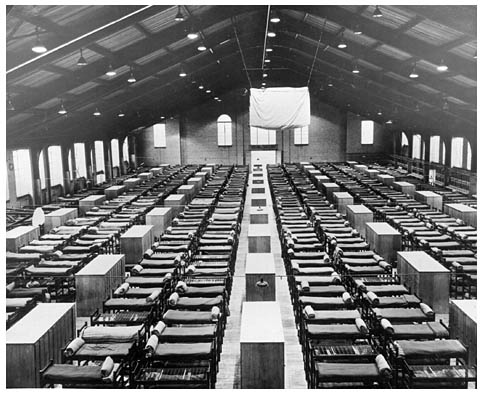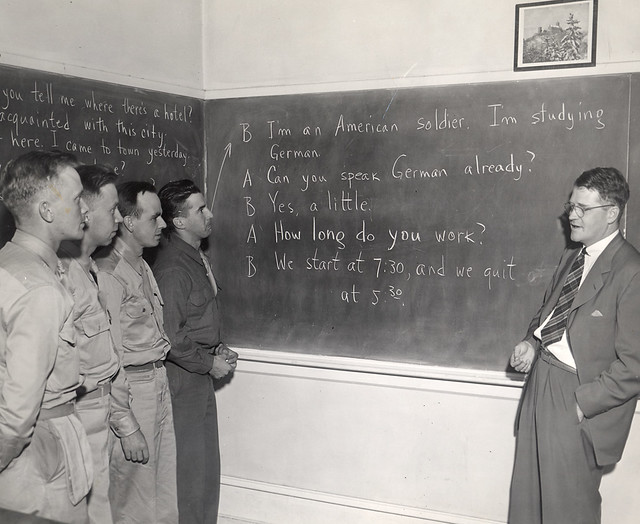|
Posted: 7/15/2014 11:48:40 PM EDT
One of the less well known programs the US Army had during WWII was called the Army Specialized Training Program, or ASTP. Expecting a long war, Secretary Stimson wanted to ensure that the Army had a supply of new quality junior officers several years into the future. ASTP took soldiers that scored well on IQ and qualification tests and sent them to civilian universities under a compressed learning schedule. During the existence of the program, over 200,000 soldiers were sent to 227 different colleges.
ASTP patch:
 "The Army Specialized Training Program ("ASTP") was established by the United States Army in December 1942 to identify, train and educate academically-talented enlisted men as a specialized corps of Army officers during World War II. Utilizing major colleges and universities across the country, the Army provided a four-year college education combined with specialized Army technical training over a period of one and one-half years to those enlisted men who were accepted into the program.
"The Army Specialized Training Program ("ASTP") was established by the United States Army in December 1942 to identify, train and educate academically-talented enlisted men as a specialized corps of Army officers during World War II. Utilizing major colleges and universities across the country, the Army provided a four-year college education combined with specialized Army technical training over a period of one and one-half years to those enlisted men who were accepted into the program.
ASTP soldiers were to serve as Army officers in both the successful prosecution of the war and the restoration of civilian governments in Nazi-occupied Europe after the war's end. But due to the impending invasion of Normandy and the need for additional manpower in its ground forces in Europe, the Army disbanded the program in early 1944. Most of the ASTP soldiers were then assigned to the infantry, where they fought in the European and Pacific Theaters of Operation."
http://www.astpww2.org/
Lodging in a converted university field house:
 The program was described as
The program was described as:
"Individuals who passed above the acceptable level were sent to an Army Specialized Training Program, which included intensive courses, approximately 25 class-time hours per quarter, in engineering, science, medicine, dentistry, personnel psychology, and 34 different foreign language at 227 land-grant universities around the country. These programs were accelerated; students were expected to complete the program in 18 months with a four-year degree and a commission. This included many volunteers from the civilian echelons who were at least 17 but less than 18 years of age.
While in academic training the soldiers were on active duty, in uniform, under military discipline, and received regular army pay. Recruits marched to class in groups, ate in mess halls located in the barracks, and trained in the fields around a campus. The soldiers week was made up of 59 hours of "supervised activity," including at least 24 hours of classroom and lab work, 24 hours of required study, six hours of physical instruction, and five hours of military instruction. At its height in December 1943, about 140,000 men were enrolled in the program.
By November 1943 the Army recognized that its replacement training centers were not producing nearly enough new soldiers for the Army Ground Forces, particularly in light of the impending invasion of France. In January 1944, Col. Beukema reported to a U. S. Congressional investigating committee that ASTP were more demanding than either West Point or the Naval Academy."
http://en.wikipedia.org/wiki/Army_Specialized_Training_Program
Learning German in college:
 Eventually the Army decided that they needed the manpower now and disbanded most of the programs, save for some medicine and engineering students. There were some issues in integrating these troops back into line units.
"About 35 U.S. divisions received an average of 1,500 men each, though some got considerably more, like the 395th Infantry Regiment, which in March 1944 received an injection of about 3000 replacements from the ASTP program.
Eventually the Army decided that they needed the manpower now and disbanded most of the programs, save for some medicine and engineering students. There were some issues in integrating these troops back into line units.
"About 35 U.S. divisions received an average of 1,500 men each, though some got considerably more, like the 395th Infantry Regiment, which in March 1944 received an injection of about 3000 replacements from the ASTP program.
The new replacements, fresh out of college, often were given a harsh reception by their Sergeants, long-term regulars who considered them a bunch of college kids who wanted to steal their stripes. The former ASTP members tended to stick together, which made it worse for themselves. The Sergeants didn't know what to make of men who preferred to go to the base exchange to pick up ice cream and soda rather than go into town and get drunk on beer. One company commander said, "what kind of soldiers deal out bridge hands during their ten-minute training breaks?" The ASTP alumni were typically not impressed by the intellect of their new officers and non-commissioned leaders. However, once in combat, the ASTP soldiers rapidly proved their worth and any distinctions between the regular Army and the college soldiers were erased."
http://military.wikia.com/wiki/Army_Specialized_Training_Program
Some of the more famous participants in the program were: Bob Dole, Henry Kissinger, NYC Mayor Ed Koch, Mel Brooks, and author Kurt Vonnegut.
It would be neat to find an online copy of this book:

|
 Win a FREE Membership!
Win a FREE Membership!